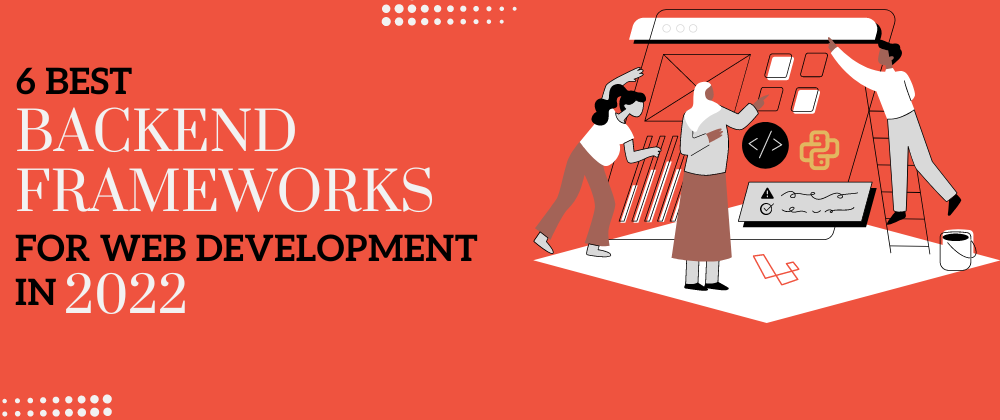Wherever the demand and market's growing, web developers are expected to grow and meet the demand by creating frameworks that will help in developing efficient and robust web apps.
Web development can be very helpful in building platforms to reach more people, but that's not the only thing they do. They also play a crucial role in the development of User Interface (UI) design. While the front-end designs work on the site or app, developers focus on developing and updating back-end code.
There are a variety of frameworks out there for backend development that might leave you in doubt about which one to choose. To avoid all the confusion, we started with this list of top 6 backend development frameworks.
1. Django
The popular Python web framework Django was released in 2005. It is open-source and scalable, customizable, and contains the required functionalities of a developer's framework.
It is a popular open-source web application framework that makes it easier to develop web applications without setting up infrastructure. It is based on an important principle called DRY, which means it's often built with reusing code in mind and structurally follows the MVC pattern. You can use the framework for developing JSON, XML, and HTML websites.
It is a web app that deploys in Python and comes with admin interfaces for CRUD operations. Popular applications using Django are Google, YouTube, Instagram, Spotify, Pinterest, DropBox, Mozilla, and National Geographic.
Features of Django
- Secure Authentication
- Batteries included
- Support of middleware
- SEO Optimized
- Huge community support
- Easy integration with third-party applications
2. Laravel
Laravel PHP framework was released in 2011. Its MVC architecture consists of libraries and extends the idea of a database structure with an intuitive interface.
WordPress is a free open-source content management platform that provides website owners with blogging tools like blogs and e-commerce websites. They also offer database tools like ORM (Object Relational Mapper) via their Laravel framework. Their advanced custom web apps use their expressive and elegant syntax. Some companies using Laravel are 9GAG, Pfizer, Crowdcube, and Razorpay.
Features of Laravel
- Own CLI (Command Line Interface)
- Integrates with MySQL, SQL Server, SQLite, and Postgres.
- Migration of database
- Simple API
- Template Engine
3. Express
Express is a framework that makes it easier to create web applications using Nodejs. It provides support for REST API applications and is also part of the MEAN and MERN stack that is used in mobile apps on both Android & iOS devices.
JS developers are using Express because it's a flexible framework for NodeJS. It allows developers to build single-page, multi-page, and hybrid applications. Express can handle GET, PUT, POST, and DELETE requests and is typically used by companies like Accenture, PayPal, Twitter, Myntra, Uber & IBM.
Features of Express:
- Routing
- Middleware
- Debugging
- Plugin support
- Extensive templates
- HTTP utility methods
4. Spring Boot
Spring Boot is a lightweight & open-source Java framework that is used for creating easy application. It has a spring core container, which provides the basic core elements of Spring, like the module that provides containers.
It is one of the most popular frameworks, following MVC architecture, and performs CRUD operations. It also has extensions for creating web applications and configurable security methods. It is easy to create beans using the Spring Framework. It has many useful functionalities like transaction management, monitoring, caching & security.
Spring Boot is becoming a popular framework for companies seeking microservices that are built on Java. It's easy to set up and faster than other frameworks like Kubernetes.
Features of SpringBoot
Simple API
Dependency management
Avoids Complex configuration of XML
Microservices
5. Ruby on Rails
Ruby on Rails is an open-source and server-side framework that works with the standard MVC architecture. It provides a structurally bug-free database to work with through HTML, CSS, and JavaScript.
The concept behind the DRY motto is to avoid repetition in coding and the idea that Conventions over Configuration can lead to maximum ways of solving problems. Companies using Ruby on Rails are GitHub, Shopify, Netflix, Airbnb, and Crunchbase.
Features of Ruby on Rails
- Good community support
- Reliable and high-quality
- Simple testing
- Scaffolding
- Localization
6. Flask
Flask is an open-source, lightweight framework that can be used for creating web applications. It takes minimal effort to learn how to work with it and it doesn't have any external dependencies, making it easy for beginners.
It supports unit testing and secure cookies, like any other framework. It also has an object-relational mapping tool that helps make any code database compatible.
LinkedIn and Pinterest are two famous companies that have used Flask as their backend framework to create both small-scale and large-scale applications.
Features of Flask
- Unicode backend
- Development server
- Rapid development
- Minimalistic
- Good documentation







Latest comments (0)